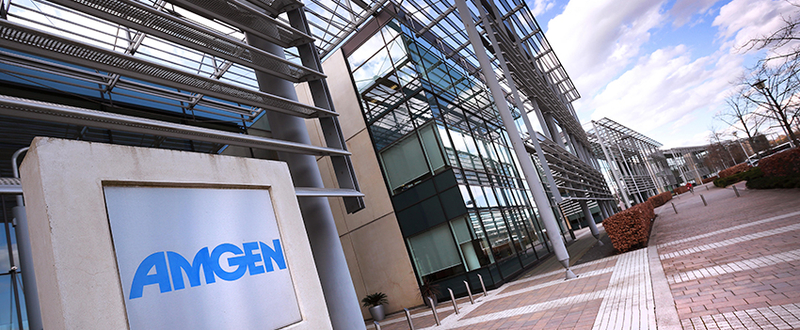After releasing dribs and drabs about its closely watched KRAS inhibitor, Amgen is pulling the curtain on full data. The treatment, known as sotorasib or AMG 510, curbed tumor growth in 88% of patients with non-small cell lung cancer (NSCLC), shrinking tumors in one-third of patients.
The phase 1 data come from 59 patients with NSCLC, who received one of four dose levels of the drug. The top dose of 960 mg fared slightly better, stifling tumor growth in 91% of patients and shrinking tumors in 35% of patients compared to the 32% figure for all dose levels. The drug also kept cancer at bay for a median of six months, though some patients went more than a year before seeing their disease worsen.
The results, presented Sunday at the virtual meeting of the European Society for Medical Oncology (ESMO), are encouraging for a patient group that has very few options. The study involved 129 patients with KRAS-mutated cancers, including NSCLC, colorectal cancer and other solid tumors. Three-quarters of them had tried two or more treatments, with all of the patients having undergone platinum chemotherapy and nearly all of them (90%) having tried a PD-1/PD-L1 drug.
“If you look at drugs like docetaxel that are typically used in this setting, the progression-free survival is usually two to three months and the response rate is in the order of 10% to 20%,” said Greg Friberg, Amgen’s vice president of global development, oncology. “We are seeing at least double from what we would anticipate to see from those available therapies.”
Sotorasib didn’t fare quite as well in colorectal cancer, shrinking tumors in just 7% of 42 patients and curbing tumor growth in 73% of them. Of the 28 patients with “other tumor types,” 14% saw their tumors shrink, while 61% saw their tumors stop growing.
The safety profile for the drug looks pretty good, too—just over half of the patients suffered treatment-related side effects, such as diarrhea, fatigue and nausea, with just 12% reporting severe effects. One patient quit the study because of side effects. There were no drug-related deaths, nor were there dose-limiting toxicities, namely side effects serious enough to stop a patient from stepping up to a higher dose.
“Hopefully this will foreshadow what we will see when we turn the cards over from the large single-arm phase 2 experiment,” Friberg said. Though that phase 2 study is “potentially pivotal,” Amgen has also kicked off a randomized phase 3 study pitting sotorasib against the chemo drug docetaxel in the second-line setting.
If sotorasib can continue its performance, industry watchers are expecting a speedy approval.
“The more important potential pivotal Phase IIB is due soon (we est Oct) and will be filed to FDA quickly if data are generally similar,” wrote Jefferies analyst Michael Yee in an investor note Sunday, adding that he expects the drug to launch in the second half of 2021.
The ESMO findings reinforce Amgen’s plan to pursue lung cancer first, but the company is chipping away at studies combining sotorasib with other cancer meds, including targeted drugs and chemotherapy, as well as testing the drug in other kinds of cancer.
There are already studies underway testing sotorasib in combination with treatments including antibodies and kinase inhibitors that target EGFR, as well as SHP2 inhibitors, MEK inhibitors and PD-1 blockers, lead author David Hong, M.D., said in an email. Hong, a professor of investigational cancer therapeutics at MD Anderson Cancer Center, presented the data on Sunday.
“Evaluating these combinations is important for two reasons,” Hong added. “First, as with other targeted therapies, we know that patients will eventually develop resistance. Additionally, there (is a) subset of patients, such as some with colorectal cancers with KRAS G12C mutations, that do not respond to KRASG12C inhibition alone. Therefore, we need to identify safe and effective combinations in order to provide patients with the best options.”
For Amgen, combinations are the “first next step” to get into other tumor types and treatment settings. “From a big picture standpoint, we look back and recognize the drug has only been in the clinic for two years. This may be the end of Chapter 1, but it’s really the beginning of the novel,” Friberg said.
Besides moving into other tumor types, what could the rest of the novel look like?
These results could pave the way for the development of other drugs like sotorasib that target other types of KRAS mutations, Hong said in a statement. Sotorasib targets one of the most common KRAS mutations, called G12C, but this mutation occurs in 13% of patients with NSCLC and 3% to 5% of patients with colorectal cancer, so there’s a lot of other ground to cover.
“There are a number of additional KRAS mutations found in cancer. For example, these would include mutations like KRAS G12D, which is the most prevalent mutation in pancreatic cancer,” Hong said in an email.
Another avenue would be figuring out if and how sotorasib could work even better and banish tumors completely. There were no complete responses in this study, “perhaps because tumors harboring KRAS mutations often have multiple oncogenic drivers,” wrote Patricia LoRusso, D.O., a professor of medicine at Yale University, in a New England Journal of Medicine editorial discussing the results.
“Dr. LoRusso is highlighting the fact that there are many unanswered questions. I wholeheartedly agree with her and want to generate data to understand some of that,” Friberg said. “It’s not uncommon in oncology not to have an answer immediately—or even ever. She’s challenging the field to continue the work we have begun. This is barely the beginning of the story.”

